Cycle News Staff | March 3, 2017
2017 Honda CRF450RX vs. Yamaha YZ450FX: FULL TEST
The original idea was simple yet brilliant: take a motocross bike and tweak it just a bit for the closed-course off-road race world.
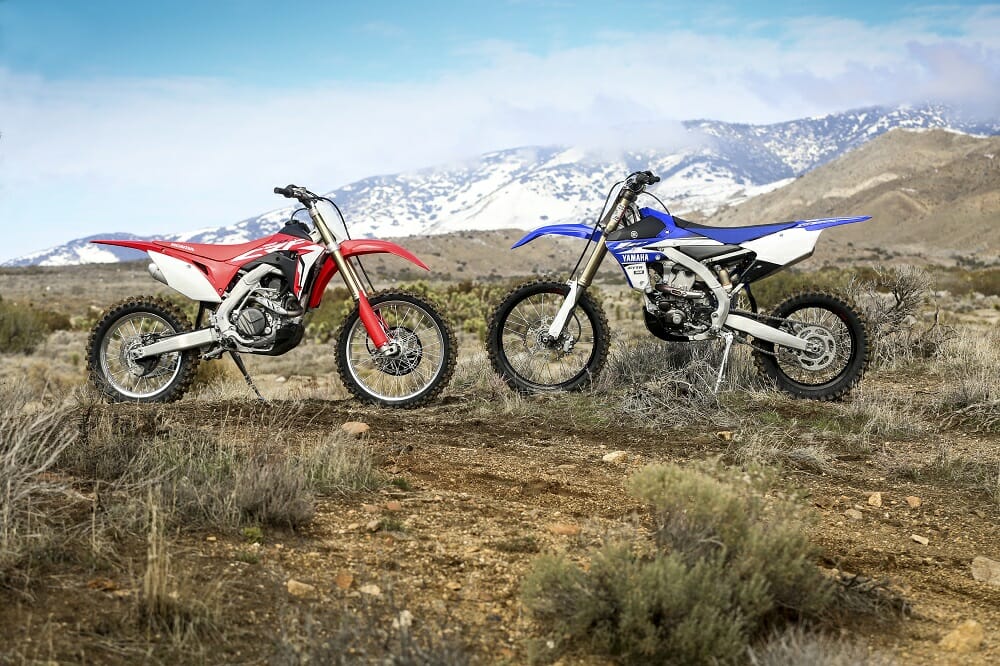 The new Honda CRF450RX (left) now challenges the Yamaha YZ450FX for trail supremacy when it comes to Japanese-built open-class, closed-course off-road racers.
The new Honda CRF450RX (left) now challenges the Yamaha YZ450FX for trail supremacy when it comes to Japanese-built open-class, closed-course off-road racers.
Until recently KTM was the only manufacturer doing it with its XC line, which KTM sells more of than any other in its entire orange line up. Just a few short years ago, Yamaha went after the XC idea, turning the YZ450F MX bike into the YZ450FX, their version of a closed-course off-road race bike. Sales and success of the YZ450FX have proven that it was an excellent move.
This brings us most recently to Honda, who has burst onto the closed-course off-road race bike scene with the 2017 CRF450RX, based heavily on the all-new CRF450R (read test). Because there are now two Japanese manufactures with models in this KTM created category, we decided to put them up against each other. Following this comparison we will be pitting the two Austrian machines, the KTM 450 XC-F and the Husqvarna FX450 up against each other as well. There are now four manufactures in the 450 closed-course off-road race bike category and we will determine a winner in a wrap-up comparison of all the machines soon. For those who want to know how the Honda CRF450RX and Yamaha YZ450FX compare, read on.
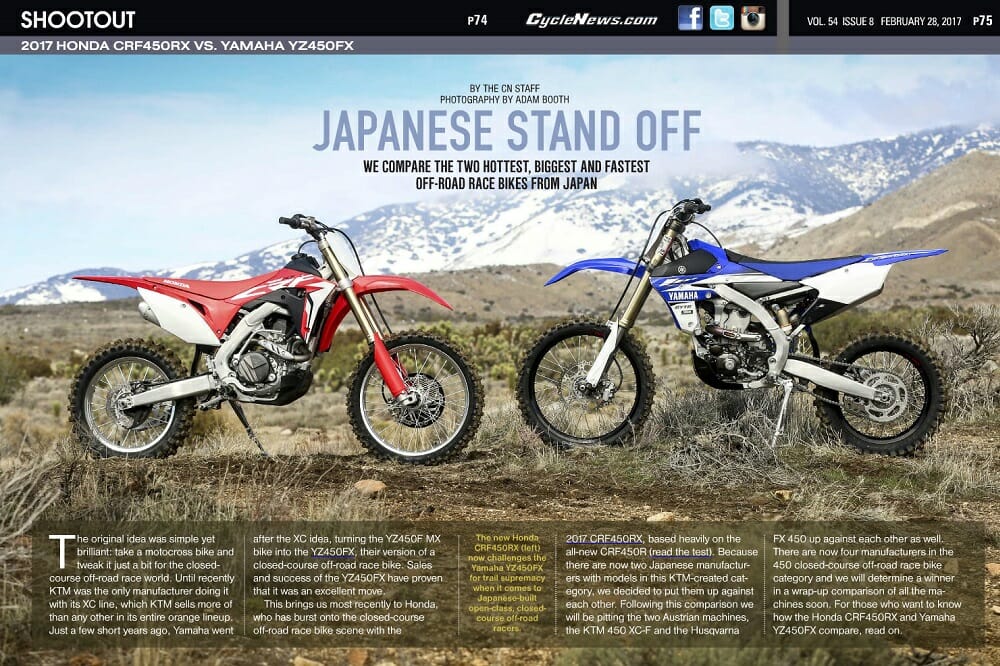
2017 Honda CRF450RX vs. Yamaha YZ450FX: FULL TEST
Click here to read the in the Cycle News Digital Edition Magazine.
Yamaha YZ450FX
Yamaha didn’t simply bolt on an 18-inch rear wheel and called it a day. They went further in the morphing process from MXer to off-roader than KTM, that doesn’t change a lot between the SX-Fs and the XC-Fs. The YZ450FX engine is very similar to the YZ450F, but comes to life via an electric start, requiring a left side case change to hold the starter and a more powerful generator. Power output went from 95 watts to 160 watts. For 2017 it no longer has a kick-starter as backup.
To smooth out power Yamaha added flywheel inertia and the FX uses a different crankshaft. One-hundred percent of the reciprocating weight is balanced by the counter-balancer; on the YZ450F it’s 88 percent.
The cylinder head and piston are the same as the motocross version and the cams are only slightly different on the FX to work in conjunction with the electric starter.
The ECU is exclusive to the YZ450FX and uses different mapping to provide more off-road friendly power. It can still be heavily tuned using the GYTR power tuner.
The transmission ratios are 30% different between the YZ450F and the YZ450FX. To theoretically match the YZ450F first gear to the YZ450FX you would add 14 teeth to the YZ450F’s rear sprocket. Then you would add eight teeth to match second gear, two teeth to match third, zero teeth to match fourth (fourth gear nearly the same), and you then subtract four teeth to match fifth gear on the FX.
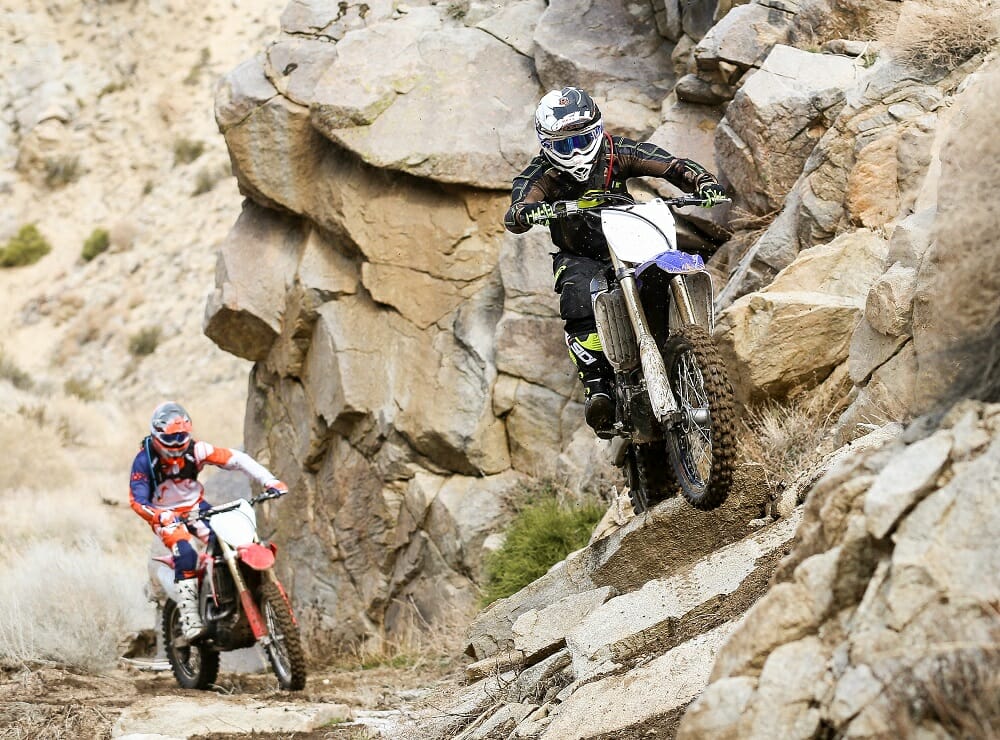 For such big, heavy and powerful bikes, both the Honda and Yamaha are remarkably agile and easy to ride on technical trails.
For such big, heavy and powerful bikes, both the Honda and Yamaha are remarkably agile and easy to ride on technical trails.
The YZ450FX suspension uses all the same components as the YZ450F and the chassis is identical as well. The internals of the suspension is where things are different for the YZ450FX. Yamaha went down five rates on the fork springs, dropping from a 5.0 N/mm to a 4.5 N/mm. The shock retains the same rate as the YZ450F at 56 N/mm. Both the shock and the fork have off-road-specific valving.
Making the engagement smoother and more controlled for off-road situations, the YZ450FX clutch uses a judder spring.
The radiator’s fin pitch and shrouds are different to aid cooling in slower conditions. There is also a spot for a radiator fan (the WR450F comes with one) if overheating ever becomes an issue. The FX now has an indicator light behind the front number plate warning of low gas and oil levels.
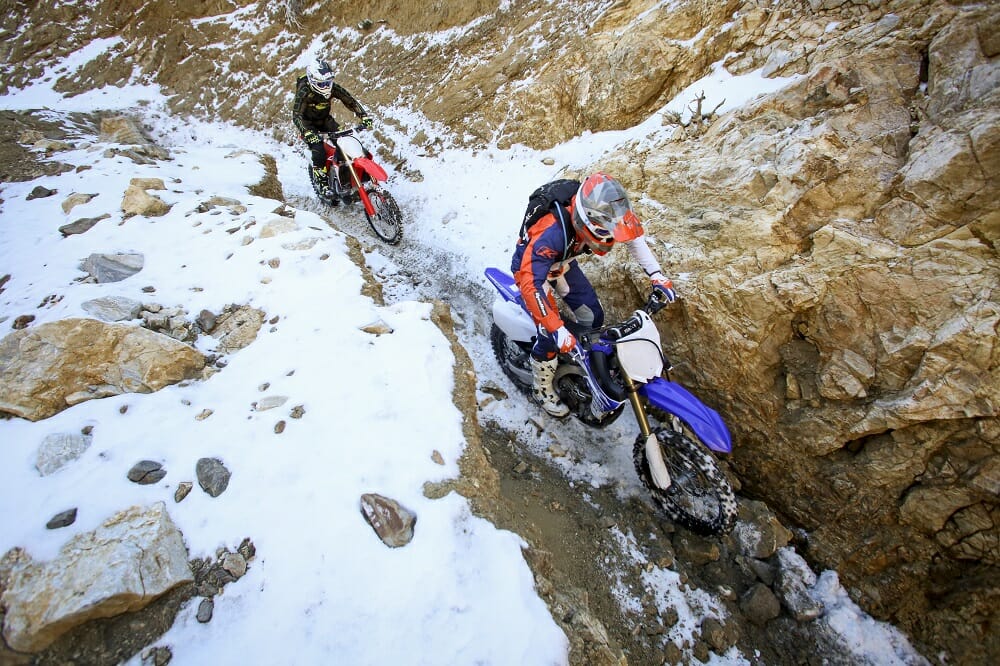 Both bikes get the job done on single-track trails, but they really shine on more open terrain.
Both bikes get the job done on single-track trails, but they really shine on more open terrain.
Honda CRF450RX
2017 is an exciting year for Honda lovers, the CRF450R is all new and much improved over previous models, so when Honda announced the CRF450RX, off-road racers were salivating at the news. Honda didn’t radically change the CRF450R to convert it into their closed-course off-road race machine, not as much as Yamaha did with the FX. The transformation starts at the rear wheel, which is an off-road worthy 18-incher.
Keeping things simple, the RX engine is exactly like the CRF450R; even the transmission is the same, no changes to the ratios. The CRF450RX ECU mapping is tuned a little more mellow for smoother roll-on power and better traction in off-road situations. The RX comes with electric starting (Honda offers an electric-starting kit for the CRF450R). The rear sprocket is one tooth bigger than the motocross version, tightening the gap between gears slightly over the motocrosser. The RX also receives an O-ring chain.
In the suspension department, the RX stays with the same spring rate up front as the CRF450R, but with softer valving. Out back the RX shock uses a softer spring rate (52 N/mm for the RX, 54 N/mm for the R) with plusher valving than the R. Helping to aid in an overall more plush feel, the CRF450RX uses thinner upper engine mounts, allow more flex of the chassis.
 (Left) The Yamaha’s five-speed transmission is tweaked to better accommodate the trails. However, the Honda’s tranny, also a five-speed, is unchanged from its MX cousin. (Right) Except for the standard electric starting, the RX’s engine is the same as the R’s.
(Left) The Yamaha’s five-speed transmission is tweaked to better accommodate the trails. However, the Honda’s tranny, also a five-speed, is unchanged from its MX cousin. (Right) Except for the standard electric starting, the RX’s engine is the same as the R’s.
Honda upped the gas tank capacity to 2.2 gallons in a plastic tank; the MXer uses a titanium gas tank. Off-road riding also means stopping in the middle of nowhere so a kickstand is standard equipment. Both the CRF450R and the YZ450FX use Dunlop AT 81 tires, a great choice for soft to intermediate off-road terrain. Thanks to EFI and electric start, both bikes put out plenty of extra power to run nice aftermarket lights if needed. It is very easy to loose three pounds just by ditching the stock lead acid battery and going with an aftermarket lithium battery on either bike.
The Honda CRF450RX mimics much of the way KTM converts its motocross bike into a closed-course off-road race bike. The KTM XC line softens the suspension settings, goes with a bit bigger gas tank, adds an 18-inch rear wheel and a kick stand, then leaves well enough alone. The engine and ECU stay the same as the motocross models and KTM doesn’t have to mess with adding electric start, their motocross bikes already have it.
 (Right) We prefer the FX’s simpler single-muffler system to the RX’s dual mufflers. Neither system, however, is equipped with a spark arrestor. (Right) Both bikes use lead batteries. A nice upgrade would be a swap for lighter lithium batteries.
(Right) We prefer the FX’s simpler single-muffler system to the RX’s dual mufflers. Neither system, however, is equipped with a spark arrestor. (Right) Both bikes use lead batteries. A nice upgrade would be a swap for lighter lithium batteries.
Comparo In The Dirto
Neither the YZ450FX nor the CRF450RX are light bikes. The motocross bikes from which they are bred do not have electric start as standard, so adding the magic button tacks on a chunk of weight, then the 18-inch rear wheel and kickstand bump up the weight with both bikes. With full gas, they both weigh in right around the 265-pound mark. As a reference, the 2017 KTM 450 XC-F weighs 238 pounds with a full tank of gas, too. Yikes!
Honda and Yamaha go different directions with the suspension spring rates in order to ready the bikes for off-road. The Honda CRF450R is softer in the back while Yamaha goes softer in the front. For general off-road riding and the average rider, the handling is pretty darn good on both bikes.
When the speeds pick up, the Yamaha suspension, especially the fork, is a bit soft, making the bike a little nervous at speed and dive under braking. Bigger, heavier and faster testers noticed the soft fork more than our average testers. The YZ450FX with a full tank of gas weighs a whooping 267 pounds on our scale. If you keep the FX moving and flowing it doesn’t feel crazy heavy; the heavy sensation kicks in when speeds drop and the trail becomes more technical. The FX is a wide feeling bike and like the motocrosser, front wheel traction is a bit vague at times, although the FX front end feels just a bit more planted thanks to the softer fork springs. The weight of the FX is also more noticeable due to the slightly unbalanced and soft suspension.
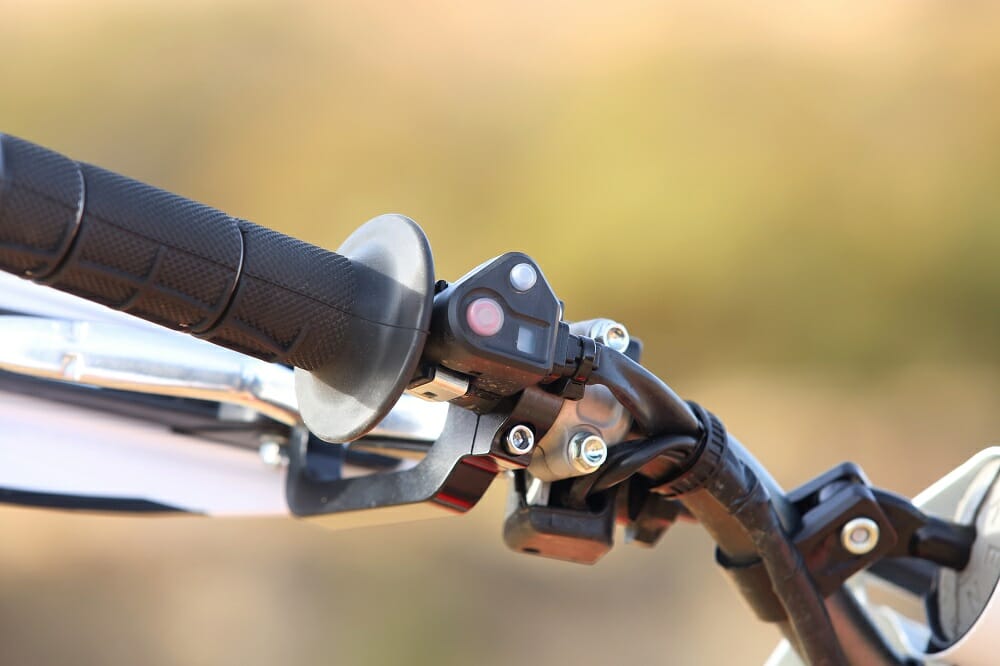 The Honda features an on-the-fly adjustable mapping switch—with three choices—on the handlebar; the Yamaha requires an accessory tuning tool but you have near-endless tuning adjustability.
The Honda features an on-the-fly adjustable mapping switch—with three choices—on the handlebar; the Yamaha requires an accessory tuning tool but you have near-endless tuning adjustability.
Weighing 264 pounds with a full tank of gas, three pounds less than the FX, the Honda CRF450RX does indeed feel lighter and more agile on the trail. The chassis is narrower and the suspension is more balanced, keeping the bike more planted and predictable. Turning on the CRF450RX is excellent and precise, adding to the nimble feel. The CRF450R is also more stable on higher speed terrain and handles aggressive hits and large whoops with ease. The ability to handle higher speeds also gives the CRF450R a little more of a harsh feel over little bumps and trail hack. The YZ450FX has more plush and comfortable suspension feel through slow to mid-speed bumps and hits.
The bottom line is that both of these bikes beat to the heart of a 450cc motocross bike. They are straight up rocket ships. Not many mortal riders need any more power; what most need is a way to properly deliver that power. The YZ450FX and CRF450RX require a delicate throttle hand and aggressive clutch work to control the abundance of power in tight, technical or slippery conditions. When it comes to this type of riding both machines are slightly different. The Yamaha’s first gear is a bit low for anything but a crawling pace and the gap to second is a bit much, requiring constant clutch work to put power down smoothly. For that reason the Honda is slightly easier to ride on a tight and technical trail. We did experience more of a tendency for the RX engine to pop-stall when compared to the YZ450FX, a trait consistent with 450 motocross bikes at low engine rpms under load, but nothing we couldn’t combat with good clutch control. The clutch pull and modulation is a bit smoother on the YZ450FX.
As the terrain allows higher speeds, the more spaced out transmission on the YZ450FX shines. This is where the Yamaha clearly has the advantage when it comes to riders who want to convert it into a desert-speed weapon. The Honda will go fast as well, it just requires a more radical gearing change than the Yamaha, since the only change from the CRF450R is one tooth bigger on the rear sprocket.
Flat out raw power is very close, although it’s not an exact scientific comparison due to the radically different transmission ratios; in drag races and hill climbs they are crazy close. The YZ450FX engine revs up quicker than the CRF450RX, making throttle control more important when traction is sparse.
We never had an issue with EFI settings or experienced any problems with response, even going from sea level to 7000 feet. The YZ450FX power is easily tuned using the GYTR Power Tuner ($300) and the Honda has three easily changed maps via the handlebar mounted map switch. We gravitated to the stock setting on the CRF450RX most of the time. Remember, these are converted motocross bikes; they thrive in more open riding where the power of the engines can be fully used and appreciated.
Both bikes come stock with open exhaust, so a spark arrestor is required to ride on public land. The dual exhaust on the Honda will make that more expensive, and somehow, despite the dual exhaust, the Honda is incredibly loud, significantly louder than the Yamaha YZ450FX.
 Our main gripe with the Yamaha? Overly soft fork springs. The Honda? Loud pipes.
Our main gripe with the Yamaha? Overly soft fork springs. The Honda? Loud pipes.
On The MX Track
If you are looking for an all-around bike, the RX and FX are great options from full-on motocross bikes. In stock form, the Honda is very capable on a motocross track. The slightly softer suspension compared to the R version is actually probably better for most riders. The same can be said for the engine, as the mellower map makes the bike a little easier to ride, but still plenty fast.
The stock suspension settings on the Yamaha YZ450FX are pretty soft for the track, epically the fork. It bottoms easily off jumps and compresses too much under hard braking, making it difficult for the front end to hold a line. Stiffer fork springs would make it much more fun and balanced on the MX track. We went with a little more sag (105-110mm) to try and help the overall balance. Both of these machines are more than capable on the MX track, as they should; after all, they started life as motocross bikes. For a lot of riders, these very could be a better choice than the MX version, minus very fast intermediate- and pro-level riders.
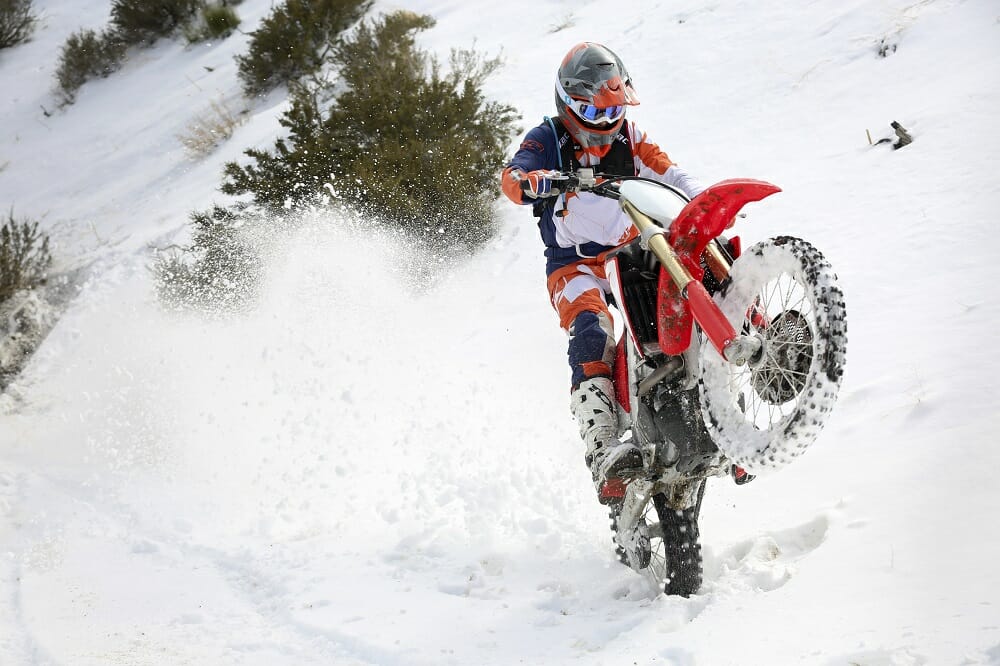 Weight is a major concern with both bikes. They are significantly heavier than their European counterparts.
Weight is a major concern with both bikes. They are significantly heavier than their European counterparts.
Seeing Red
We rode these bikes through the open desert, flowing single track, pinned it up monster hill climbs and navigated first and second gear, rocky and technical terrain. We even spent time on the motocross track. These bikes are designed as closed course off-road racers, which means going fast in a variety of terrain. Think GNCC, WORCS, National Hare & Hound and desert races. They aren’t hard enduro bikes or even dedicated single-track machines. Both Yamaha and Honda have 450 trail bikes, the WR450F and the CRF450X. Across the board every one of our test riders leaned toward the Honda CRF450RX as the choice between the two bikes. The larger tank and better stock suspension makes this bike very capable of racing comfortably in almost any type of off-road racing. The bonus, it is great on the motocross track in stock form. The YZ450FX isn’t as at home at higher speeds, but it is just a bigger gas tank and stiffer forks away from being a possible comparo winner.
But, as they stand right now, right out of the crate, the RX would be our choice come the next GNCC race. CN

|
|
|
SPECIFICATIONS
|
2017 Yamaha YZ450FX
|
2017 Honda CRF450RX
|
|
MSRP:
|
$8,999
|
$9,249
|
|
ENGINE:
|
Liquid-cooled, 4-stroke, single
|
Liquid-cooled, 4-stroke, single
|
|
DISPLACEMENT:
|
449cc
|
449.7cc
|
|
BORE X STROKE:
|
97.0 x 60.8mm
|
65.5mm x 66.2mm
|
|
COMPRESSION RATIO:
|
12.5:1
|
13.5:1
|
|
FUEL DELIVERY:
|
EFI
|
EFI
|
|
STARTING SYSTEM:
|
Electric
|
Electric
|
|
TRANSMISSION:
|
5-speed
|
5-speed
|
|
FINAL DRIVE:
|
N/A
|
13/50
|
|
FRAME:
|
Aluminum
|
Aluminum
|
|
FRONT SUSPENSION:
|
48mm KYB spring fork, fully adj.
|
49mm Showa spring fork, fully adj.
|
|
REAR SUSPENSION:
|
KYB single shock, fully-adj.
|
Showa single shock, fully-adj.
|
|
FRONT WHEEL TRAVEL:
|
12.2 in.
|
12.0 in.
|
|
REAR WHEEL TRAVEL:
|
12.5 in.
|
12.2 in.
|
|
FRONT WHEEL:
|
90/90×21 in.
|
90/90×21 in.
|
|
REAR WHEEL:
|
120/90×18 in.
|
120/90×18 in.
|
|
FRONT BRAKE:
|
270mm disc
|
260mm disc
|
|
REAR BRAKE:
|
240mm disc
|
240mm disc
|
|
RAKE/TRAIL:
|
26.3°/4.5 in.
|
27°/4.6 in.
|
|
GROUND CLEARANCE:
|
12.8 in.
|
12.9 in.
|
|
SEAT HEIGHT:
|
38.0 in.
|
37.8 in.
|
|
WHEELBASE:
|
57.7 in.
|
58.1 in.
|
|
FUEL CAPACITY:
|
2.0 gal.
|
2.2 gal.
|
|
WEIGHT (Wet):
|
267 lbs.
|
264 lbs.
|